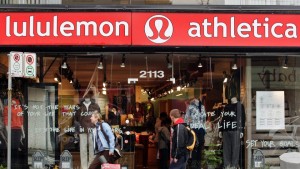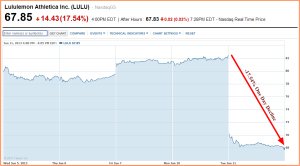The idea had been thoroughly vetted and researched. Two years of consumer analysis led Lululemon to an idea of how to engage the Buffalo, New York community with their brand (Christmann, 2014). Upon opening their Walden Galleria store, they unveiled a floor mosaic with the words, “wide right, no goal” prominently displayed. This didn’t resonate well with Nunie Williams, so just before going out to walk with her dogs, she posted on her Facebook and Tweeted about her displeasure (Christmann, 2014). The outrage went viral, and by that evening, Lululemon took to social media to apologize for the offense (Christmann, 2014). The mosaic was covered with a rug until it could be torn out and replaced (Christmann, 2014). Lululemon had monitored trending social media and used the information to quickly respond to a public relations failure, limiting the damage to their brand.
Lululemon heavily embraces an integrated marketing communication plan. They are present in all major media, including television, radio, print, and Internet. Their heavy social media presence has consistently assisted their organization in messaging with their consumers. One danger of being present in so many media channels is the risk of repetition and monotony. Brands can suffer negative associations if they simply repost the same photographs or literature pieces across various media (Creativeconcepts.com, 2015). Lululemon is flourishing on social media by actively connecting with their product’s consumers and responding to their feedback (Creativeconcepts.com, 2015).
Another Lululemon crisis that was both inflamed and addressed through integrated marketing was the aptly named “pantsgate.” Lululemon has built their brand on the image of quality and comfort. In early 2013, the yoga pants that Lululemon was selling had consumers complaining that the fabric was too sheer, and that they were see through when consumers were bending over. Social media blew up with stories of consumers being treated harshly by store employees, some even claiming that they were forced to put the pants on and bend over to prove that they were too sheer (Hsu, 2013). These stories went viral, and a brand crisis exploded.
Lululemon eventually declared a recall for all the yoga pants made during that period, with no questions asked (Hsu, 2013). However, this did not come in time to avert an economic hit to the financial performance of the company. Lululemon stock shares dropped by six percent, after they reported slower than expected sales and growth (Isidore, 2013).
Lululemon’s nimble reaction to this crisis through their integrated marketing plan helped to minimize this negative impact (Crenshaw, 2013). Through press releases and social media platforms, Lululemon provided consumers with information about why the product had failed, what they were going to do to mitigate the impact on consumers, and how they would prevent this from happening in the future (Crenshaw, 2013). This strategy has helped alter the course of Lululemon’s financial trajectory, which is once again trending up (Halzack, 2015).
References:
Christmann, S. (2014). Lululemon received a lesson in social media. The Buffalo
News.
CreativeConcepts.com. How Lululemon Gets Multi-Platform Content Strategy Right.
Retrieved June 9, 2015, from http://creative-conceptsllc.com/lululemon-
multiplatform-content-strategy/
Crenshaw, D. (2013). Crisis management lessons behind the headlines.
Business2Community.
Hsu, T. (2013). “Pantsgate” to hurt Lululemon profit; customers told to “bend over.”
Los Angeles Times.
Isidore, C. (2013). Lululemon lowers forecasts, share plunge. Money.CNN.Com.
Halzack, S. (2015). Lululemon is finally recovering from “Pantsgate” and other
problems. The Washington Post.





2 Responses to Lululemon: Crisis Management Through Integrated Communication